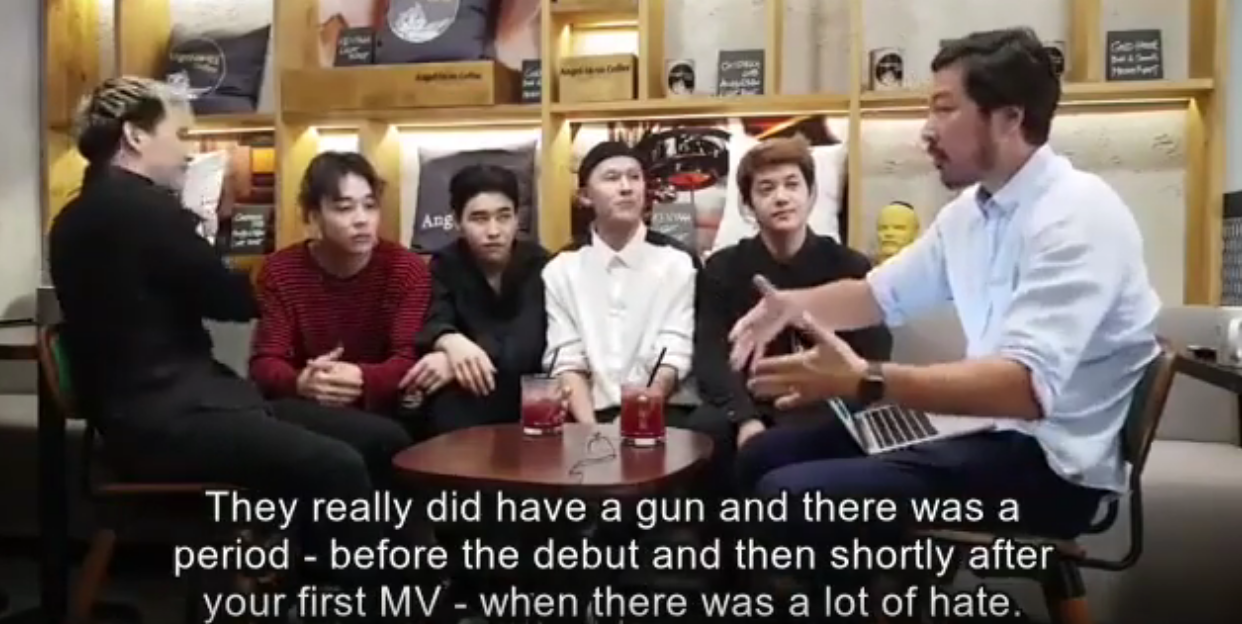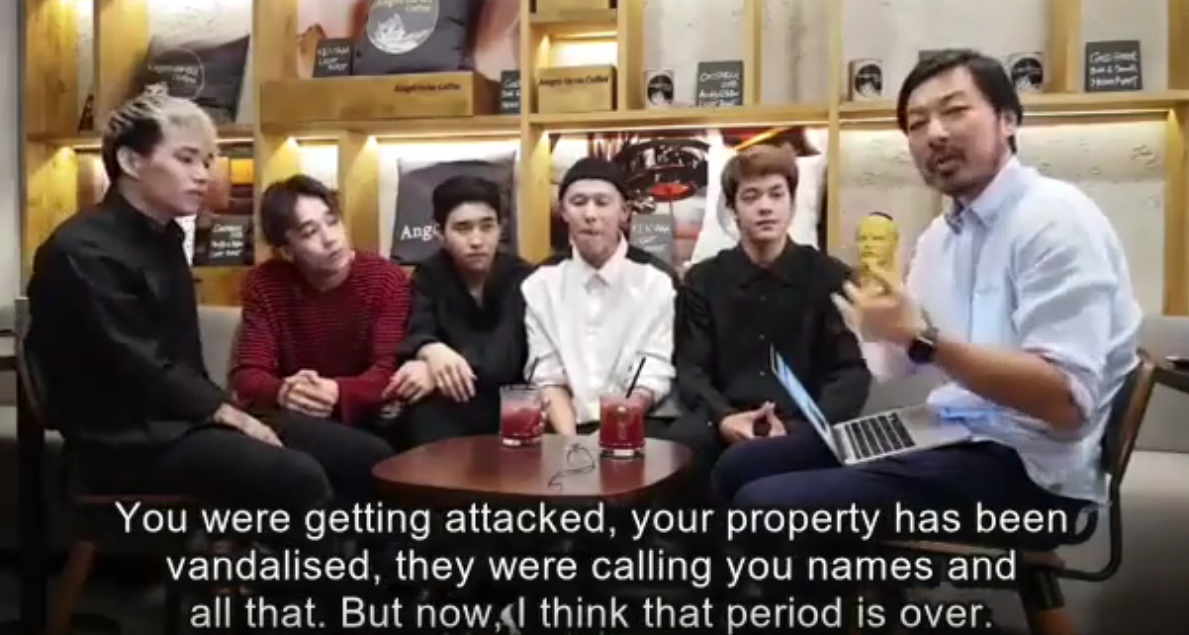Part 4: Bring Them the Head of Kenesary Khan
Of Ninety One’s nationalism, and idol pop worldwide in the service of soft power.

In the previous essay I noted that not all of Ninety One’s videos, including the goofy non-musical one-offs, come with English subtitles. A glorious exception is a video they posted in mid-2019. Like the best idol content, it’s simultaneously funny and revealing; and like the best Ninety One content, it requires some explanation of the local context.
In this case you have to know a thing or two about how education works in Kazakhstan.1 Everyone is expected to attend school until ninth grade. After finishing ninth grade, students have the option of continuing in secondary school or switching to a vocational track at a technical school or lyceum. If they continue in secondary school, after eleventh grade they have the opportunity to take the Unified National Test, or UNT, which functions as both a graduation test and a possible entryway into public universities.
Of the five members of Ninety One, only one (ZaQ) stayed in school long enough to take the UNT. Nonetheless, last year someone at Juz Entertainment got the idea to film the members offering encouragement to those about to take the upcoming UNT, in part by themselves attempting to answer the kinds of questions that might be on the UNT.
The resulting video is frankly worth watching just for the moment where AZ surprises the entire filming crew by rattling off all the planets in the solar system in order of increasing distance from the sun. But it also features the following question:

Which translates to: “Where is the head of the Kenesary Khan?”
The guys do much better with this question than they did with the solar-system one.
Bala: I know that it’s in Russia.
AZ: In Russia. I want to get it back.
ZaQ: In Moscow? I know it’s in Russia.
Ace: In Kokshetau… actually, the tombstone is located there, in the Borovoy. But his head is in Moscow.
Alem: In St. Petersburg, in the museum. [tone sounds to indicate he’s right]
Ace: It’s used as an ashtray.
Bala: If it returns, then this will happen… [starts laughing]
AZ: If there are guys who want to help me get it back…
ZaQ: Return it!
AZ: My telephone number is 8775…
Alem: It should be returned, by the way.
Bala: You all will be in trouble if it gets returned.
AZ: Let’s get together and get it back. If not for my sake, then for somebody’s!
ZaQ: It’ll be good if we can get it back.
AZ: For all our sakes!
Bala: [shakes his finger at the camera] If it comes back, I won’t spare anyone!
Alem: No, listen, there is a legend about the head of the Kenesary. If his head comes back to our country, then our country will become, whoa!
I’m not sure there exists footage of any other idol-pop group discussing a decapitated head at such length.
Kenesary Khan is regarded as the last true khan (leader) of the Kazakh Khanate, a confederation of tribes that dated back to the 15th century. He was elected khan in a meeting of the tribes in 1841 and spent his six years in power fighting against takeover by then-Czarist Russia (which had been trying to control central Asian territory for over a century at that point), but was assassinated by a Kyrgyz khan, and his head was subsequently sent to Russia. Alem may not be right, by the way: this essay, on a website sponsored by the Kazakhstani Ministry of Information and Social Development, suggests that the skull may be in storage maintained by Gokhran, a division of the Russian Ministry of Finance tasked with storing precious metals and jewels. Possession of the head was apparently an issue in diplomatic talks as late as 2016, when the Russian government returned a different head, that of twentieth-century rebel Keiki Batyr, to Kazakhstan.
In other words, the lost head of Kenesary Khan is a symbol of smarting Kazakhstani national pride, important enough to be asked of would-be entrants to Kazakhstan’s most prestigious universities. And the members of Ninety One clearly care much more about the lost head of the Kenesary Khan than they do about whether or not Pluto is still a planet—because they are a group of Kazakhstani nationalists. What’s more, talking about smarting national pride in the course of a jokey adorkable video is not an anomaly: as with promoting the Kazakh language, they see their idol work as advancing the reputation and recognition of their country. And in thinking so they are firmly in idol-pop tradition.
Just as BTS’s “War of Hormone” dance-practice video was the purest shot of idol adorkability, the purest shot of idol pop in the service of nationalism is the video for the 2013 single “Koi Suru Fortune Cookie,” by that behemoth of Japanese idol pop, AKB48:
By the mid-2000s, Japanese idol pop was no longer attracting as eager audiences as it had in earlier decades. AKB48, the “idols you can meet”—a rotation of members performed daily at a theater in Akihabara, the Tokyo neighborhood that gave the group its name—was the next innovation in Japanese idol pop, and it proceeded to dominate the Oricon charts for the next decade. As Patrick St. Michel argued late last year in one of his Japan Times columns, AKB48 relies on existing idol-pop strategies, expanded.2 An AKB48 member might start out as an aw-shucks tarento, but she could improve her skill as fans followed her from year to year, minor to big leagues (the 109 AKB48 members are divided up among several different teams with varying levels of prestige, not counting sister groups in other cities). Monetization? To cast multiple votes for their favorite in the special “general elections,” fans had to get tickets, which could only be acquired by buying multiple copies of the same album. Adorkability? This was a group that staged an annual rock-paper-scissors challenge to see which girl would be “center” in the next video, costumes optional but encouraged.
In keeping with idol-pop standards, AKB48’s music didn’t have to be well regarded by music hipsters outside Japan, or even the Japanese public; it just had to be palatable enough for fans to sit through long enough to see their fave. “Koi Suru Fortune Cookie” is an exception: much better than that standard, and much more ambitious. It’s not just a sweet, catchy disco-sprinkled pop song; it’s a sweet, catchy disco-sprinkled pop song rather explicitly pitched at a national audience potentially depressed by economic doldrums, social pessimism, and the Fukushima disaster less than two years earlier. The opening monologue3 makes this clear:
What’s up, Japan! Can you hear me? Is life gettin’ you down? No money, no job, too much bad news? Well, there’s no reason to be down. It’s time to get up! We have a hot new song that’s from AKB48, to make you feel good! Koi Suru Fortune Cookie. So dance, Japan, CRAZY!
This is followed by the members of AKB48 leading a huge parade, with cutaways to all manner of residents of Japan—office workers, preschoolers, kendo students, nightclub hostesses in slinky dresses, Kenny Omega—dancing along, and one AKB48 member acting as surprised weathergirl showing a map of Japan covered by “Dance Fever.” Meanwhile the song itself includes the lines Even God won’t know / What’s coming next / Fortune cookie in tears / Don’t take it so negative / Hey! Hey! Hey! / The world is filled with love / And let us forget sadness / By the new wind that will blow tomorrow. It’s all very sweet, until you consider its implications for the argument that while God might not have known what was coming next, Tokyo Electric Power Company should have done a better job guessing.4
This is the most common form of idol-pop nationalism: upbeat, danceable, deliberately uncritical. Think of Geri Halliwell’s Union Jack minidress at the 1997 Brit Awards, or ABBA’s “Dancing Queen,” first performed in honor of a royal Swedish wedding. Or “Seoul,” a collaboration between Korean idol-pop groups SNSD and Super Junior, showing off the titular city. SNSD is still occasionally referred to as the “Nation’s Girl Group” (though it’s not entirely clear who confers such titles). Other Korean idols have been designated the “Nation’s Little Sister” (solo artist IU)5 and “Nation’s First Love” (Suzy, then of the group Miss A).
Moreover, Korean idol pop has a fairly cozy relationship with the Korean military. Male idols aren’t exempt from military service, and a whole set of rituals has evolved for groups and their fans alike when an idol has to interrupt his career for nearly two years: the dramatic sendoff, the counting down, the equally dramatic welcoming back.6 Even BTS, with their not-inconsiderable contributions to Korean GDP, will start sending members to the military next year. (Discussing why it would be unthinkable for the BTS members to ask for an exemption, British journalist Taylor Gladsby, a Korean idol-pop expert, explained, “They’re proud sons of South Korea.”) The female groups’ role, meanwhile, is to support the boys in the army by performing, smiling, and looking pretty, not unlike Betty Grable once upon a time. Sometimes they actually appear in military advertisements; sometimes they’re modeling in military magazines; sometimes they’re holding concerts for a screaming moshpit of conscripts in berets. There is also a ritual of, when a male idol returns from his required tour of duty, asking him which female idol “gave him strength” during his service, in case you weren’t convinced enough that idol pop, sex, and national defense were intertwined.
Korean pop may not be all that exceptional in this regard; lots of countries have a mechanism to send entertainers to the troops à la the USO. But it remains the most succesful of the current idol-pop scenes, inspiring groups from China to Mongolia to the Philippines to Kyrgyzstan to, yes, Kazakhstan. And for the Korean idol-pop industry, cheerful nationalism has been part of the promotional package for a long time.
The catch-all term for the rapid rise in popularity of Korean products in popular culture and entertainment is “Hallyu Wave.” It is generally said to have been coined in the late 1990s, not by anyone in Korea but by a Chinese newspaper, and the prompt was a pair of Korean soap operas entrancing Chinese television audiences: What Is Love All About? and Star in My Heart. According to Euny Hong’s book The Birth of Korean Cool7, a Korean civil servant sent copies of What Is Love All About?, which had commanded a huge market share in Korea, to Hong Kong, where it eventually aired on the ATV network, which could be picked up in China’s Guangdong province as well as Hong Kong itself. At the same time, H.O.T., the idol group we met back in Part 2, was gaining a Chinese audience—they would perform their first Beijing concert in 2000—while a crop of independent Korean films (including the debut film of Bong Joon-ho, Barking Dogs Never Bite, released in 2000) was attracting increasing global acclaim.8
These successes came during democratic South Korea’s darkest hour, economically speaking. The economic crisis that had begun with a collapse in Thailand’s currency led to disaster for South Korea: the government’s credit rating was downgraded, many of its biggest companies needed emergency loans, and the won collapsed. In December 1997 the South Korean government accepted a $58 billion loan from the International Monetary Fund; to this day what in the United States is referred to as the “Asian financial crisis” is called the IMF crisis in Korea. Although the economy began growing again quickly (by 2001 the loan had been fully repaid, ahead of schedule) the sudden and brutal nature of the crisis was apparently psychologically devastating to Koreans at the time.9
It was in the immediate aftermath of the IMF crisis that Kim Dae-jung, then president of South Korea, began pursuing a policy of encouraging the sale and distribution of Korean cultural products abroad. The Ministry of Culture, now named the Ministry of Culture, Sports, and Tourism, began directly funding entertainment ventures. The Korean Creative Contents Agency (KOCCA) was established in 2005; so was the Korean Venture Investment Corporation, a partially government-funded fund management group that maintains a for-profit fund earmarked for pop-cultural ventures. The Ministry has also, through KOCCA, sponsored events designed to promote Korean idol pop abroad, such as the idol-pop-featuring, Korean-culture-themed convention KCON and “K-Pop Night Out” events at South by Southwest.10 Meanwhile, KBS, the national public broadcaster, has been broadcasting the weekly music show Music Bank since 1998; MBC, also a public broadcaster, airs the weekly music show Music Core; and both broadcast shows which regularly feature the most popular idols, such as Immortal 2 and Yoo Hee-Yeol’s Sketchbook (KBS) or King of Masked Singer, Weekly Idol, and I Live Alone (MBC).
It would be a mistake to think that the idol-pop companies are directly managed by the Korean government. (Or that the Korean government funds only idol pop.) A better characterization of the situation would be that the Korean government provides a certain amount of infrastructure to support idol pop, and the occasional small direct boost to reach audiences overseas.
Remember how, back in Part 1, I mentioned that in 2011, French idol-pop fans were conducting flash mobs to get SM Entertainment to add more concerts in Paris? According to Hong’s book, even this was partly the work of Korean government officials. The then-director of the Korean Cultural Centre in Paris came up with the idea of a Paris concert, got funds from the Ministry of Culture, and then, when SM Entertainment proved reluctant to commit to the venture, came up with the idea of the “spontaneous” flash mobs, and arranged for journalists to be present. “Like many Hallyu success stories,” Hong concludes, “this one was brought about by a harmonious effort of government, industry, and fans.”
The intertwining of government funding and entertainment production in Korea has gotten complicated enough that an article on Parasite’s Oscar win for Best Picture can state plausibly that “Parasite received absolutely no support from the Korean government” while discussing the role the film’s distributor, CJ E&M, played in wooing Oscar voters. CJ E&M is a conglomerate formed in 2011 from the merger of five media companies; its holdings include the TV channel Mnet, whose slogan used to be “We Are K-pop,” and the music label Stone Music Entertainment, which works with a number of idol-pop managing companies. CJ E&M (which also runs KCON, by the way) is a subsidiary of the larger CJ Group, which is in itself a spinoff of Samsung, one of the original chaebol promoted by the military dictatorship of Park Chung-hee in the early 1960s.11
The economic rewards accumulated by the likes of CJ E&M or Big Hit Entertainment, BTS’s parent company, now estimated to be worth $4 billion, make Kim Dae-jung look impressively farsighted in retrospect. But the Korean government’s support of entertainment and cultural exports was never exclusively about finding new revenue sources in the wake of the IMF crisis. By putting attractive, desirable faces on Korean products, it was a way to market Korea itself as attractive and desirable to its Asian neighbors-slash-audiences, to the world, and also not incidentally, to Koreans themselves, who had just suffered a nasty blow to their collective national self-regard.
The usual shorthand for this is “soft power.” (As opposed to hard power, backed by military or economic might.) Joseph Nye, a longtime teacher and eventual dean at Harvard’s Kennedy School of Government, coined the term, so let’s let him define it:
Soft power is not merely the same as influence. After all, influence can also rest on the hard power of threats or payments. And soft power is more than just persuasion or the ability to move people by argument, though that is an important part of it. It is also the ability to attract, and attraction often leads to acquiescence. Simply put, in behavioral terms, soft power is attractive power. Soft power resources are the assets that produce such attraction.
If I am persuaded to go along with your purposes without any explicit threat or exchange taking place—in short, if my behavior is determined by an observable but intangible attraction—soft power is at work. Soft power uses a different type of currency—not force, not money—to engender cooperation. It uses an attraction to shared values, and the justness and duty of contributing to the achievement of those values.
One way to appreciate the value of soft power is to reflect on the worldwide response to the fire at Paris’s Notre Dame cathedral last year. Millions of people who had neither ever been to Paris nor attended a Mass were sorrowfully riveted—partly because the live video of the fire was itself compelling, but also because Notre Dame is one of the most famous churches in the world, in one of the best-imagined cities in the world.12 People “know” Paris: accordion music, fashionably dressed women walking fashionably dressed poodles, existentialists smoking Gauloises at cafés, and so on. The idea of Paris is compelling enough to produce soft power, and soft power produced nearly $1 billion in pledges to help with Notre Dame’s renovation.
Korea does not yet have so much soft power that Seoul’s Changdeokgung Palace, first built in the early 15th century, is as well known worldwide as Notre Dame. But if you watch enough Korean idol pop, you can start tentatively grasping scattered elements of Seoul life—noraebangs, fried-chicken deliveries, the Ferris wheel at Wolmi Theme Park, constant traffic, relaxing on the banks of the Han River. There are now tourism listicles aimed at K-drama watchers, and the official Korean tourism website features a similar list for ARMYs looking to visit spots they’ve seen in BTS’s videos or on their album covers. In other words, Korean idol pop helps its fans “know” Korea, help them form hazy and simplistic but benevolently inspiring images of Korea. The idea of the “Koreaboo,” the fan so in love with Korean idol pop as to uncritically glom on to everything even vaguely Korea-related, is in itself a testament to the growth of Korean soft power.
That Korea would covet soft power in particular makes some sense in light of its experiences in the last century or so. Both T. K. Park, a longtime blogger writing about Korea for Western audiences, and John Lie, a University of California, Berkeley sociologist who wrote a 2012 book on K-pop, have argued that the history of Korean popular music in the 20th century is essentially a history of Korea’s colonizers. Trot, historically the best-known genre of Korean popular music, bears similarities to Japanese enka music; whether trot is actually a derivative of enka, or was simply influenced by having to come of age while Korea was under Japanese rule, is a long-standing (and politically charged) debate. American-style rock ‘n’ roll, meanwhile, only entered Korea because American soldiers demanded it. “In the late 1950s,” Lie wrote, “revenues from performances for US GIs probably exceeded the total export earnings of South Korea.” Here’s how Park describes the process:
In a country reduced to ruins, the only gig available for Korean musicians was to play for the Americans. They had to audition before a USO panel, who would give them a license (a literal piece of paper, pictured above) to play at one of the US GI clubs. In order to win the audition, the Korean musicians had to learn the latest American hits, the Elvises and James Browns that the US soldiers liked to hear. New music implanted by a massive foreign army who occupied your capital—cultural transmission does not get much more imperialistic than that.
If we could ask Kim Dae-jung, his administrators, and their successors whether pop music has power, their collective answer might well be: yes, and we’d like some of that for our country, thank you very much.
Ninety One’s debt to Korean idol pop has never been a secret. It wasn’t just choosing stage names (a common strategy in Korea where multiple idols might have the same first and last names), or recruiting a Korean-trained member, or alternating between sung and rapped verses in every song. The group has also performed along Korean groups at Kazakhstani Korean-idol-pop themed concerts and traveled to Korea twice: once in 2019, which included the I Can See Your Voice appearance, and once in 2018, where they brought along Korean-language recordings of their songs to potentially sell to Korean singers.
Along with the stylistic and aesthetic inspiration, Ninety One also also paid attention to the role of Korean idol pop in increasing Korean soft power, and of Korea’s government in increasing Korean idol pop’s reach. This is also not a secret. In fact, ZaQ gave a whole speech about it.
The occasion in question was an official gathering of the Zhas Otan, the youth-focused wing of Nur Otan, the political party of Kazakhstani longtime president and self-proclaimed father of the country Nursultan Nazarbayev. (There are no other political parties in Kazakhstan allowed enough power to be worth discussing. We’ll get to that issue later.) Zhas Otan meetings apparently get a fair bit of state-directed publicity, and it was this publicity ZaQ was presumably counting on when he made his speech:13
At the moment, Ninety One is bringing a new direction to show business, creating a new Q-pop culture. What is the main goal of this direction?
To add content in the Kazakh language to all music industries, that is, music genres, TV show programs, other areas related to show business–and to prove that Kazakh culture, language and art can be comprehensive!
I would like to give the Korean subculture K-pop as an example. Why Korea? Because we are all Asian.
To be brief, the most important thing in this subculture is that it is the main source of tourism in Korea. This is a big business, which annually brings an income of $5 billion to the country! Why? Because the Korean subculture K-pop is supported by the government at the state level, in order to reach the world level! Q-pop is also capable of this. I think there is definitely potential here. Our greatest achievement is that according to official figures, we have fans in 120 countries of the world!… Our foreign listeners became interested in the sound of the Kazakh language, they began to learn the Kazakh language, and began to send us video messages—in Kazakh!….
With your support, we can not only develop in our country, the heritage of Kazakh culture, language, art, and code, but we can raise it to the world level! I want to turn to fellow musicians. We must unite to develop art that affects the economy of our country, and bring Kazakhstan to the world level!
This was not a one-off. “I can proudly say that we are creating ‘’Made in Kazakhstan’,” Yerbolat Bedelkhan, Juz Entertainment’s founder and Ninety One’s manager, told an interviewer in 2016.14 In 2020 the group gave an interview to the Korean English-language newspaper JoongAng Daily that included a lot of bragging about Kazakhstan: “Since we are the descendants of nomads, a freedom-loving people, this whole mix pours into our free creativity.”
And thus the members are not idols first and Kazakhstani patriots indignant over the treatment of Kenesary Khan second. The idol pop and the patriotism are inseparable. Ninety One is a deliberate effort to increase Kazakhstani soft power.
Can you blame them? As global soft-power rankings go, Kazakhstan has to be close to the bottom. It’s not that people in the West have an incomplete or wrong impression of Almaty, as compared to Seoul or Paris; it’s that people in the West have no impression of Almaty. The opening scene of Borat was actually filmed in Romania. “The reason we chose Kazakhstan,” Sacha Baron Cohen told Rolling Stone in 2006, “was because it was a country that no one had heard anything about.”15
This is the vacuum Ninety One wants to fill. They want to get fans accustomed to hearing Kazakh, but also in thinking of Kazakhstan as a recognizable, relatable place. In “Kaytadan,” the group’s second music video, the Almaty backdrop is as much as a city as the mock-Kazakhstan of Borat was a ramshackle village. Here we have subways, and streetlights, and chic malls.
The nonmusical content is even better for promoting this kind of soft power. One of my favorite examples of this is the fourth episode of 91 TV, in which Bala is declared king for the day, and proceeds to abuse his power in intentionally comical ways. When he orders Ace and AZ to go buy him nuts and Coke Zero, off they have to run to the closest magazin, or convenience store.

It’s one thing to read that there’s a magazin on practically every block in Almaty; it’s another to actually see how the products are lined up on the shelves and how people push past each other in the aisles. Once you know that shopping at an Almaty magazin is something like, say, shopping at a Korean deli in New York, Almaty, and the people who live in it, and Kazakhstan itself, all become less of a blank.
So: Ninety One is following in the pattern set by idol pop in general and Korean idol pop in particular, not just in their musical and extra-musical presentations, but in their explicit claim to make these presentations as proud citizens representing their country. If the pattern holds, this effort should be regarded with warmth by the Kazakhstani government and benign bemusement, at worst, by the Kazakhstani populace. Right?
Wrong:


What happened? I’ll explain that next.
Back to Part 3: Idol Pop and the Languages of Love
On to Part 5: The Loyalties of Little Fresh Meat
Egov.kz, a Kazakhstani government website, provides a detailed description of the UNT. See also Anna Pons et al., “OECD Reviews of School Resources: Kazakhstan,” OECD Publishing, 2015.↩︎
Patrick Galbraith and Jason Karlin, the team behind Idols and Celebrity in Japanese Media Culture, have written a book on AKB48 for the Bloomsbury 33 1/3 series; I will confess to not having seen it yet.↩︎
And, I’m embarrassed to say I don’t know the name of the deejay who delivers said monologue. If you do, please shoot me an email.↩︎
There’s a lot out there on TEPCO’s responsibility for the Fukushima disaster; for a short summary see Chico Harlan, “Report blasts Japan’s preparation for, response to Fukushima disaster,” Washington Post, July 5, 2012.↩︎
Her response to this was the 2015 single “Twenty-three,” which is simultaneously a sly piece of commentary on idol-pop life and an absolute bop.↩︎
As I write this it is now 24 days to October 26th, by the way.↩︎
Gyu Tag Lee’s 2013 doctoral dissertation, “De-Nationalization and Re-Nationalization of Culture: The Globalization of K-Pop,” has more on the creation of H.O.T. and their subsequent success in China. For more information on the Korean independent film boom of the late 1990s, or Korean film generally, your go-to person is Darcy Paquet, who wrote the English subtitles for Parasite. Barking Dogs Never Bite also features Parasite star and longtime Bong collaborator Song Kang-ho, by the way; it’s not as over-the-top as Parasite (I’ve heard), but if you liked Parasite, or somewhat dark comedies in urban settings generally, you should go find it.↩︎
See Steven Borowiec, “IMF 20 Years On: S. Korea’s Never-ending Crisis,” Korea Exposé, December 29, 2017.↩︎
Hong discusses government funding at length in The Birth of Korean Cool, but you can also find details in Kang Ah Park’s 2008 master’s thesis, “The Growth of Cultural Industry and the Role of Government: The Case of Korea.” Jinwon Kim discusses government funding of KCON in “Hallyu and Korean America: Transnational Connections Through Cultural Consumption in New York City,” a chapter in A Companion to Korean American Studies, edited by Rachael Myung Joo and Shelley Sang-hee Lee and published by Brill in 2018 (thanks to Melissa Johnson for the pointer). Finally, see this machine translation of a 2016 Korea Herald article by Kim Pyeong-hwa, which describes how Choi Soon-sil, a notorious adviser to then-President Park Geun-hye, embezzled money awarded by the entertainment conglomerate CJ E&M by the Ministry of Culture, Sports, and Tourism to pay for the “food experience exhibition” at KCON France.↩︎
For more on Park Chung-hee’s economic development policy, see Cho Young-chol, “The Chaebol Regime and the Developmental Coalition of Domination,” in Lee Byeong-chon (editor) and Eungsoo Kim and Jaehyun Cho (translators), Developmental Dictatorship and the Park Chung-hee Era: The Shaping of Modernity in the Republic of Korea, published by Homa & Sekey Books in 2006.↩︎
The SoftPower 30, an index co-produced by PR consultancy Portland Communications and the USC Center for Public Diplomacy, ranked Korea 19th, and France first, in its most recent edition.↩︎
Unfortunately I’ve yet to find a human translation of the speech into English; the quotation is Google Translate’s take on the Russian subtitles, with some modifications on my part.↩︎
Marina Khegay, “Employed without toi: How does the most provocative group Ninety One from Kazakhstan live,” Caravan, September 29, 2016. The quote is from a machine translation.↩︎
According to Atlas of Wonders, the “Kazakhstan” scenes of Borat Subsequent Moviefilm were also filmed in central Romania. There’s one scene in the sequel that takes place in Lilburn, Georgia, about a half-hour’s drive northeast of my house, which means I probably live closer to a Borat shooting location than Ninety One ever has.↩︎

